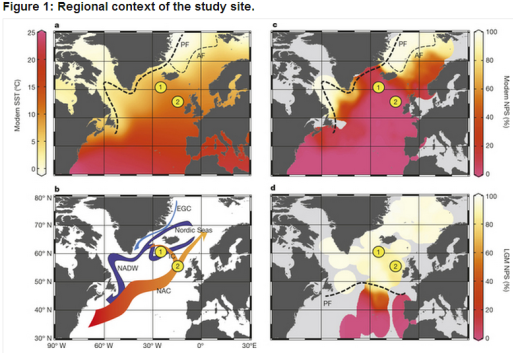
Abrupt climate change is a ubiquitous feature of the Late Pleistocene epoch1. In particular, the sequence of Dansgaard–Oeschger events (repeated transitions between warm interstadial and cold stadial conditions), as recorded by ice cores in Greenland2, are thought to be linked to changes in the mode of overturning circulation in the Atlantic Ocean3. Moreover, the observed correspondence between North Atlantic cold events and increased iceberg calving and dispersal from ice sheets surrounding the North Atlantic4has inspired many ocean and climate modelling studies that make use of freshwater forcing scenarios to simulate abrupt change across the North Atlantic region and beyond5,6, 7. On the other hand, previous studies4, 8 identified an apparent lag between North Atlantic cooling events and the appearance of ice-rafted debris over the last glacial cycle, leading to the hypothesis that iceberg discharge may be a consequence of stadial conditions rather than the cause4, 9, 10, 11. Here we further establish this relationship and demonstrate a systematic delay between pronounced surface cooling and the arrival of ice-rafted debris at a site southwest of Iceland over the past four glacial cycles, implying that in general icebergs arrived too late to have triggered cooling. Instead we suggest that—on the basis of our comparisons of ice-rafted debris and polar planktonic foraminifera—abrupt transitions to stadial conditions should be considered as a nonlinear response to more gradual cooling across the North Atlantic.
Although the freshwater derived from melting icebergs may provide a positive feedback for enhancing and or prolonging stadial conditions10, 11, it does not trigger northern stadial events.We investigated fluctuations in surface ocean temperature and the delivery of ice-rafted debris (IRD) to a site in the northeast Atlantic (Ocean Drilling Program (ODP) site 983; 60.4° N, 23.6° W, 1,984 m depth; Fig. 1) at high temporal resolution (177 years on average) over the past ~440 kyr (2,474 discrete samples). To this end we counted the relative proportion of the polar planktonic foraminifer, Neogloboquadrina pachyderma, within the total assemblage (%NPS; see Methods) and the number of lithogenic/terrigenous grains >150 μm per gram dry sediment (IRD per gram; see Methods). Today the location of ODP site 983 is under the influence of the warm surface Irminger Current (part of the modern subpolar gyre) as it turns northwards after splitting from the North Atlantic Current (NAC), which itself transports about 7.5 Sv (1 Sv = 106 m3 s?1) of warm (~8.5 °C) water over the Iceland–Scotland Ridge and into the Nordic Seas12 (Fig. 1). This inflow is balanced in part by the outflow of cold fresh surface waters via the East Greenland Current but predominantly (~6 Sv) by overflows of cold dense bottom waters through the Denmark Strait and across the Iceland–Scotland Ridge that form as a result of strong wintertime cooling and convection within the Nordic Seas12. Together, these overflows represent the principal constituent precursors to North Atlantic Deep Water (NADW) and therefore represent an essential component of the modern Atlantic Meridional Overturning Circulation (AMOC)12.
http://www.nature.com/nature/journal/v520/n7547/full/nature14330.html

